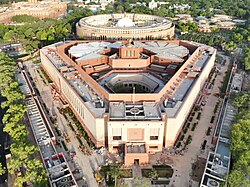| Old Parliament House | |
|---|---|
Samvidhan Sadan | |
 Old Parliament House as seen from Rajpath | |
| Former names |
|
| General information | |
| Status | Retired and under restoration |
| Type | Heritage |
| Architectural style | Classical and Indian |
| Location | Sansad Marg, New Delhi, Delhi, India |
| Coordinates | 28°37′02″N77°12′29″E / 28.6172°N 77.2081°E |
| Groundbreaking | 12 February 1921 |
| Opened | 18 January 1927 |
| Owner | Government of India |
| Design and construction | |
| Architects | |
| Other information | |
| Public transit access | |
The Old Parliament House, officially known as the Samvidhan Sadan (Constitution House), was the seat of the Parliament of India between 26 January 1950 and 18 September 2023. It housed the Lok Sabha and the Rajya Sabha (the lower and upper houses) respectively in India's bicameral parliament for nearly 73 years. Earlier it had served as the seat of the Imperial Legislative Council between 18 January 1927 and 15 August 1947, and the Constituent Assembly of India between 15 August 1947 and 26 January 1950.
Contents
- Early history
- Background
- Planning and design
- Construction
- Inauguration
- As the Council House
- 1929 bombing
- Post-independence
- 2001 attack
- New Parliament House
- Museum of Democracy
- Gallery
- See also
- References
- Citations
- External links
The building was designed by British architects Edwin Lutyens and Herbert Baker and was constructed between 1921 and 1927. It was opened in January 1927 as the seat of the Imperial Legislative Council and was known as the Council House. Following the Indian Independence in 1947, it was taken over by the Constituent Assembly of India, and then became the seat of the Indian Parliament on 26 January 1950 with India becoming a republic following the adoption of the Indian Constitution.
A New Parliament House, built adjacent to this building was inaugurated on 28 May 2023, and replaced the old Parliament building.












